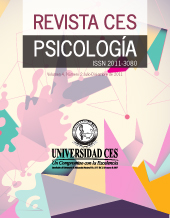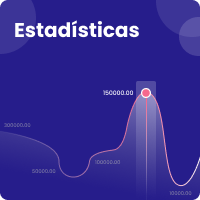EVALUACIÓN DE LA RETENCIÓN AUDIO VERBAL EN NIÑOS DE 5 A 12 AÑOS DE UNA POBLACIÓN URBANA DE MÉXICO (Evaluation of auditory-verbal retention in children aged 5 to 12 in an urban population of Mexico)
Resumen
El objetivo de la presente investigación fue describir y comparar las ejecuciones en tareas que evalúan la retención audio verbal en niños preescolares y escolares. Participaron 210 niños (30 niños por cada grado escolar), del tercer grado de preescolar al sexto grado de primaria de escuelas oficiales urbanas del estado de Puebla-México. Se aplicó la “Evaluación Neuropsicológica Infantil Puebla-Sevilla”, instrumento derivado de la neuropsicología histórico-cultural, el cual se dirige a la valoración de diversos factores neuropsicológicos. Se encontraron diferencias cualitativas y cuantitativas en las ejecuciones de los niños, dependientes del grado escolar. En los primeros grados se observó menor cantidad de aciertos y mayor cantidad de errores, el más frecuente fue la disminución del volumen de la información. Se analiza la utilidad de contar con la caracterización de ejecuciones típicas de una población infantil mexicana de niños normales, precisando las diferencias cualitativas y cuantitativas entre grados escolares, y no según la edad, como frecuentemente se realiza.
Palabras clave: Neuropsicología Infantil, Retención Audio Verbal, Evaluación Neuropsicológica, Desarrollo Cognitivo.
Abstract
This research aims to describe and compare the executions of the tasks for assessing auditory- verbal retention in preschool and school children. The participants of the study were 210 children from third preschool level through sixth grade of primary school (30 from each school grade). The study took place in public institutions in the city of Puebla (Mexico). The protocol of "Neuropsychological Assessment for children in Puebla-Sevilla", which is an instrument derived from historical and cultural neuropsychology, was used. The instrument includes items for evaluation of diverse neuropsychological factors. According to the school grade, quantitative and qualitative differences were detected in children’s execution. First grades of primary school presented severe errors, being the reduction of information amount one of the most frequent evidences. The article analyses the usefulness of common executions in children without difficulties in their development. Quantitative and qualitative differences are specified conforming to the school grades on behalf of chronological age.
Keywords: Child Neuropsychology, Audio-Verbal Retention, Neuropsychological Assessment, Cognitive Development.
Descargas
Referencias bibliográficas
Acevedo, A., Loewenstein, D. A., Barker, W. W., Harwood, D. G., Luis, C., Bravo, M., & Duara, R. (2000). Category fluency test: normative data for English-and Spanish-speaking elderly. Journal of the International Neuropsychological Society, 6(07), 760-769.
Adan, A. (1992). Circadian variations in psychological measures: a new classification. Chronobiologia, 20(3-4), 145-161.
Adan, A. (1995). La cronopsicología, su estado actual: una revisión. Revista Latinoamericana de Psicología, 27(3), 391-428.
Alsina, À. (1998). Aproximación a los ritmos de rendimiento escolar: fundamentos y aplicaciones actuales. Aula de innovación educativa, 1998, núm. 75, p. 72-76.
Ardila, A. (1999) A neuropsychological approach to intelligence. Neuropsychol Rev, 3, 117-3
Atkinson, G. & Speirs, L. (1998). Diurnal variation in tennis service. Percept Motor Skills, 86, 335–38.
Barker-Collo, S. L., Feigin, V. L., Lawes, C. M., Parag, V., Senior, H., & Rodgers, A. (2009). Reducing Attention Deficits After Stroke Using Attention Process Training A Randomized Controlled Trial. Stroke, 40(10), 3293-3298.
Barrera-Osorio, F., Maldonado, D., & Rodríguez, C. (2012). Calidad de la educación básica y media en Colombia: diagnóstico y propuestas. Documentos CEDE, (41).
Bennett, C. L., Petros, T. V., Johnson, M., & Ferraro, F. R. (2008). Individual differences in the influence of time of day on executive functions. The American journal of psychology, 349-361.
Beşoluk, Ş. (2011). Morningness–eveningness preferences and university entrance examination scores of high school students. Personality and Individual Differences, 50(2), 248-252.
Biederman, J. (2005). Attention-deficit/hyperactivity disorder: a selective overview. Biological psychiatry, 57(11), 1215-1220.
Carrier, J., & Monk, T. H. (2000). Circadian rhythms of performance: new trends. Chronobiology international, 17(6), 719-732.
Castillo, M. (2009). La atención. Madrid: Ediciones Pirámide.
Folkard, S., & Rosen, S. D. (1990). Circadian performance rhythms: some practical and theoretical implications [and discussion]. Philosophical Transactions of the Royal Society of London. B, Biological Sciences,327(1241), 543-553.
Furham, A. y Hughes, K. (1999). Individual difference of night work and shift-work rotation. Personality and Individual Differences, 26, 941-959
Garrido, I., & Rojo, C. (1996). Motivación, cognición y rendimiento. Revista de psicología general y aplicada: Revista de la Federación Española de Asociaciones de Psicología, 49(1), 5-12.
Gomes, H., Molholm, S., Christodoulou, C., Ritter, W., & Cowan, N. (2000). The development of auditory attention in children. Frontiers in Bioscience, 5, 108- 120.
González, B y Ramos (2006) Estimulación cognitiva por ordenador. Publicado como documento de trabajo. Recuperado el 17 de 2011 de http://mundoasistencial.com/guias/guias-estimulacion-cognitiva/estimulacion-cognitiva-por-ordenador.pdf
Halligan, P. W., & David, A. S. (2001). Cognitive neuropsychiatry: towards a scientific psychopathology. Nature Reviews Neuroscience, 2(3), 209-215.
Hayashi, M., & Hori, T. (1998). The effects of a 20‐min nap before post‐lunch dip. Psychiatry and clinical neurosciences, 52(2), 203-204.
Hederich,C; Camargo, A y Reyes, M, E. (2004). Ritmos cognitivos en la escuela. Bogotá. Universidad Pedagógica Nacional, División de Gestión de Proyectos, Centro de investigaciones.
Horowitz TS, Cade BE, Wolfe JM, Czeisler CA. (2010). Searching night and day: a dissociation of effects of circadian phase and time awake on visual selective attention and vigilance. Psychol Sci, 14(6):549–557.
James, W. (1890). The principles of Psychology. (Vol1). Nueva York: Henry Holt
Karbach, J., & Kray, J. (2009). How useful is executive control training? Age differences in near and far transfer of task‐switching training. Developmental science, 12(6), 978-990.
Mani, T. M., Bedwell, J. S., & Miller, L. S. (2005). Age-related decrements in performance on a brief continuous performance test. Archives of clinical neuropsychology, 20(5), 575-586.
McDowd, J. M., Filion, D. L., Pohl, P. S., Richards, L. G., & Stiers, W. (2003). Attentional abilities and functional outcomes following stroke. The Journals of Gerontology Series B: Psychological Sciences and Social Sciences, 58(1), P45-P53.
Medina, J. A., Aguilera, J. C., Poza, A. M., & Sánchez, F. R. (2012). El tiempo de trabajo y la jornada laboral en España. Fundación 1o de Mayo.
Monk, T. H. (2005). The post-lunch dip in performance. Clinics in sports medicine, 24(2), e15-e23.
Morales, J. F. D. (2002). La atención en la escuela: variaciones en dos tipos de jornada. Ritmos psicológicos y jornada escolar, 30.
Morales, J. F. D., & García, M. A. (2003). Relaciones entre matutinidad-vespertinidad y estilos de personalidad. Anales de Psicología, 19(2), 247-256.
Natale, V., Alzani, A., & Cicogna, P. (2003). Cognitive efficiency and circadian typologies: a diurnal study. Personality and Individual differences, 35(5), 1089-1105.
Norman, D. y Shallice, T. (1986). Attention to action: willed and automatic control of behaviour. En R. Davidson, G. Schwartz y D. Shapiro (Eds.), Consciousness and self-regulation (pp. 1-18). Nueva York: Plenum Press.
Ordóñez, O. (2003) Procesos Psicológicos Básicos. En S. Ochoa y O. Ordoñez Morales (Comps), Revisión Del Estado Del Arte Del Conocimiento En Psicología.
Owens, D., Macdonald, I., Tucker, F., Sytnik, N., Totterdell, P., Minors, D & Waterhouse, J (2000). Dirunal variations in the mood and performance of highly practiced young women living under strictly controlled conditions. British Journal of Psychology, 91, 41-60.
Papalia, D. E., Olds, S. W., Feldman, R. D., Herrera, M. V., Martínez, J. F. J. D., & Salinas, M. E. O. (2001). Desarrollo humano. Bogotá: McGraw-Hill.
Peretti, C. S., Danion, J. M., Gierski, F., & Grangé, D. (2002). Cognitive skill learning and aging: a component process analysis. Archives of clinical neuropsychology, 17(5), 445-459.
Perry, R. J., Watson, P., & Hodges, J. R. (2000). The nature and staging of attention dysfunction in early (minimal and mild) Alzheimer’s disease: relationship to episodic and semantic memory impairment. Neuropsychologia,38(3), 252-271.
Posner, M. (2007). Evolution and development of self-regulation. Nueva York: Department of Anthropology, The American Museum of Natural History.
Ríos, M., Periáñez, J. A., & Muñoz-Céspedes, J. M. (2004). Attentional control and slowness of information processing after severe traumatic brain injury. Brain injury, 18(3), 257-272.
Román Lapuente, F., & Sánchez Navarro, J. P. (1998). Cambios Neuropsicológicos Asociados Al Envejecimiento Normal .Anales de Psicología, 14(1), 27-43.
Roselló, J. (1997). Psicología de la atención. Introducción al estudio del mecanismo atencional. Madrid: Pirámide.
Santrock, J. W. (2006). Desarrollo cognitivo en la vejez. In J. W. Santrock (Ed.), Psicología del desarrollo: El ciclo vital. Madrid: McGrawHill.
Scarmeas, N., Levy, G., Tang, M. X., Manly, J., & Stern, Y. (2001). Influence of leisure activity on the incidence of Alzheimer’s disease. Neurology, 57(12), 2236-2242.
Shallice, T. (1988). From neuropsychology to mental structure. Cambridge University Press.
Sieroff, E. & Piquard, A. (2004). Attention and aging. Psychologie & Neuropsychiatrie du Vieillissement, 2(4), 257-69
Smith, C., Reilly, C. y Midkiff, K. (1989). Evaluation of three circadian rhytm questionnaires with suggestions for an improved of morningness. Journal of Aplied Psy chology, 74, 728-738.
Sohlberg, M. & Mateer, C. (2001). Cognitive rehabilitation an integrative neuropsychological approach: Introduction to cognitive rehabilition. Nueva York: The Guilfords Press.
Valdez, P., Ramírez, C., García, A., Talamantes, J., & Cortez, J. (2010). Circadian and homeostatic variation in sustained attention. Chronobiology international, 27(2), 393-416.
Valdez, P., Ramírez, C., García, A., Talamantes, J., Armijo, P. & Borrani, J. (2005). Circadian rhythms in components of attention. Biological Rhythm Research, 36(1/2),57–65.
Valdez, P., Reilly, T. & Waterhouse, J. (2008). Rhythms of mental performance. Mind, Brain and Education, 2(1), 7–16.
Wagner, M. & Karner, T. (2006). Vienna Teset System Manual Cognitrone versión 37.00. Mödling
Zanín, L., Gil, E., & De Bortoli, M. (2004). Atención y memoria: su relación con la función Tiroidea 2000. Vol. 12, Supl. nº 2, pp. 442-446
Publicado
Cómo citar
Número
Sección
Licencia
Revista CES Psicología ISSN 2011 3080
Facultad de Psicología, Universidad CES Primera edición 2008. Última actualización Mayo 18 de 2022. Todos los derechos reservados. Hecho el depósito legal que exige la ley.
Se autoriza la reproducción total o parcial de los artículos citando la fuente y el autor. This publication may be reproduced by mentioning the source and the authors.
| Estadísticas de artículo | |
|---|---|
| Vistas de resúmenes | |
| Vistas de PDF | |
| Descargas de PDF | |
| Vistas de HTML | |
| Otras vistas | |



